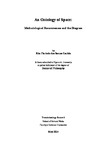An Ontology of Space: Methodological Recursiveness and the Diagram
| dc.contributor.supervisor | Punt, Michael | |
| dc.contributor.author | Cachao, Rita | |
| dc.contributor.other | Faculty of Arts, Humanities and Business | en_US |
| dc.date.accessioned | 2015-07-03T14:58:35Z | |
| dc.date.available | 2015-07-03T14:58:35Z | |
| dc.date.issued | 2015 | |
| dc.identifier | 10093494 | en_US |
| dc.identifier.uri | http://hdl.handle.net/10026.1/3411 | |
| dc.description | Full version unavailable due to 3rd party copyright restrictions. | |
| dc.description.abstract |
Current debates on space reveal a dichotomy between two apparently conflicting understandings of space: on the one hand, space is understood as a physical, tangible entity that has an impact on how we perceive, feel and emotionally inhabit the world, and on the other hand, space is conceived as an abstract entity, suggesting that space has no active role (a productivity) within everyday life, being solely a conceptual product of intellectual reasoning. As a result, the commonly used word: ‘space’, will be discussed as an ontologically paradoxical, ambiguous and elusive concept; a concept that cannot be captured within a single definition. This thesis consequently researches the ontology of space by informing a framework that embraces the complexity of space as an ambiguous and unrepresentable entity. It aims to reconcile the multiple understandings of space, liberating it from the binary thinking that opposes the abstract to the physical, disclosing its potential productivity. This thesis thus proposes a methodology departing from a transdisciplinary approach that addresses the variability, multiplicity, paradoxicality and ambiguity of space through a ‘bastard’ epistemology that defies binary logic by considering what falls out of order and norm. To research an ontology through a bastard epistemology is to work outside of (but in combination with) the intelligible and sensible realms, through a framework that is non-representational, but instead enactive and performative, driven by experience, affect and aesthetics; thus allowing access to an entity that is both ambiguous and also unrepresentable. In doing so, this thesis argues that space is diversely implicated in the constitution of research methodologies through its interactions with order and structures, as well as agential in the constitution of understandings of human interactions with the world; and therefore, it will be argued, space has methodological purchase. The consequence of this methodological purchase is that space can reveal itself if a research strategy is implemented that works through the multiple dimensions of space. Within this context the diagram will be introduced as a productive path because enables a bastard epistemology to work through the multiplicity of space, since the diagram, is a performed, materialised outcome of multiple experiences of the making of order through the interaction between physical and conceptual dimensions. In synthesis, the diagram is used to recursively research an ontology of space, showing the main contribution of this thesis: of how without negating its complexity and multiplicity, space can be useful, constructive and productive within contemporary contexts of research methodologies. | en_US |
| dc.description.sponsorship | FCT, Fundacao para a Ciencia e Tecnologia | en_US |
| dc.language.iso | en | en_US |
| dc.publisher | Plymouth University | en_US |
| dc.subject | Space | en_US |
| dc.subject | Khora | en_US |
| dc.subject | Chora | en_US |
| dc.subject | Diagram | en_US |
| dc.subject | Methodology | en_US |
| dc.subject | Ontology of Space | en_US |
| dc.subject | Recursiveness | en_US |
| dc.subject | Methodological Recursiveness | en_US |
| dc.subject | Multiple Existence of Monsters | en_US |
| dc.subject | Transdisciplinarity | en_US |
| dc.subject | Transdisciplinarity and Arts | en_US |
| dc.title | An Ontology of Space: Methodological Recursiveness and the Diagram | en_US |
| dc.type | Thesis | |
| plymouth.version | Edited version | en_US |
| dc.identifier.doi | http://dx.doi.org/10.24382/3988 |
Files in this item
This item appears in the following Collection(s)
-
01 Research Theses Main Collection
Research Theses Main



